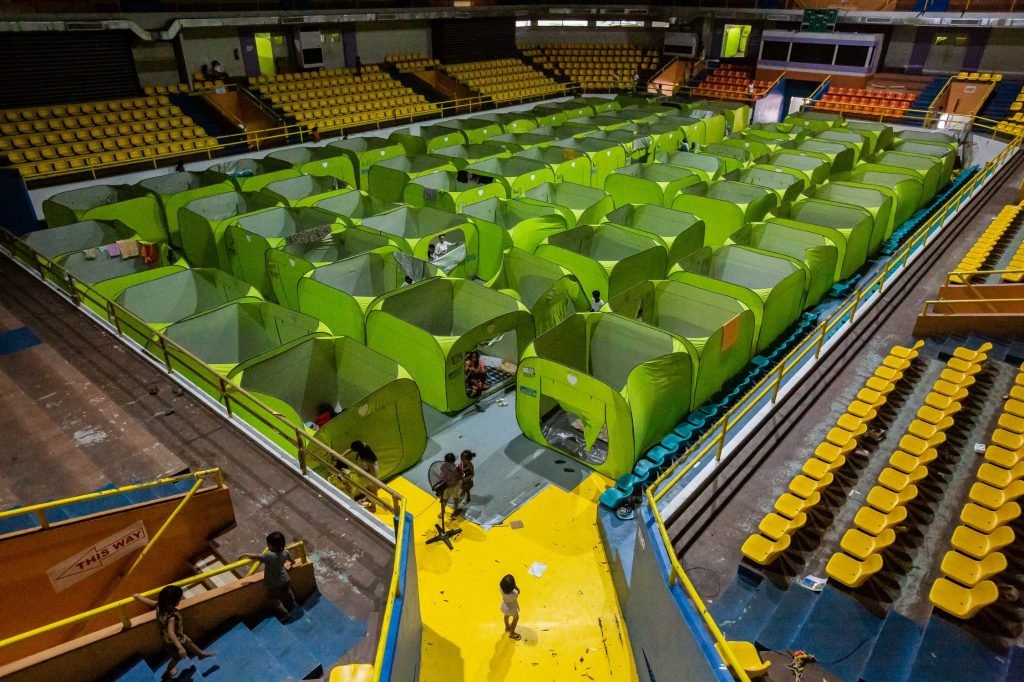
READY FOR EVACUEES A stadium in Legazpi City, Albay, has been converted as early as Thursday into an evacuation center for families fleeing the wrath of Typhoon Pepito. —Mark Alvic Esplana
MANILA, Philippines — Close to half a million people have been evacuated in the storm-battered Bicol region and about 65,000 more were told to take shelter away from their homes in coastal areas of Eastern Visayas along the path of Super Typhoon Pepito (international name: Man-yi) as it barreled toward Luzon on Saturday.
With maximum winds of 195 kilometers per hour and gusts of up to 240 km/h, Pepito moved northwestward at 20 km/h toward Bicol’s island province of Catanduanes, according to the Philippine Atmospheric, Geophysical and Astronomical Services Administration (Pagasa).
READ: Pepito’s strength reaching peak intensity, possible catastrophic level
It noted an “increasing chance” that the center of the typhoon may veer slightly away from the landmass and not directly hit Catanduanes province around midnight on Saturday or early Sunday as earlier projected.
“But the effect on the whole of Bicolandia would still be the same whether it directly hits land or not,” said weather specialist Loriedin De La Cruz-Galicia.
Article continues after this advertisement
Pepito is projected to blow west northwestward across Luzon, affecting the southern, northern and central parts of the island, including Metro Manila, due to the supertyphoon’s “wide diameter.”
Article continues after this advertisement
Aside from Catanduanes, Pepito may also make a landfall between Aurora and Quezon province, and on the eastern coast of Camarines Sur or Albay over the weekend.
“Widespread incidents of severe flooding and landslides” are expected in Camarines Norte, Camarines Sur, Catanduanes and Albay as Pepito’s powerful winds will be accompanied by torrential rains that may reach more than 200 millimeters, Pagasa said.
The state weather agency warned of “life-threatening” storm surges with heights of 2.1 meters to 3 meters in the coastal areas of Isabela, Aurora, Batangas, Quezon, Albay, Camarines Norte, Camarines Sur, Catanduanes, Sorsogon, Eastern Samar and Northern Samar provinces.
2 storms in a month
All the provinces in Bicol, which was battered by two other storms last month, ordered the evacuation of families living in houses and areas vulnerable to strong winds, prone to landslides, floodings and storm surges.
As of Saturday morning, 491,258 people belonging to 139,614 families had been evacuated from the six Bicol provinces, reports said. This number was expected to rise as authorities implemented forced evacuation.
Pepito will be the sixth major storm to pound the Philippines in the past month. In October, floods and landslides brought by Severe Tropical Storm Kristine (Trami) and Super Typhoon Leon (Kong-rey) killed 162 people with 22 missing, according to the government.
Four storms churned in the western Pacific Ocean at the same time this month for the first time since records began in 1951, the Japan Meteorological Agency said.
Heed local alerts
Most of the establishments, private and government offices in the region were closed and classes at all levels in private and public schools were suspended as early as Thursday.
Authorities warned residents in coastal villages, near waterways, flood- and landslide-prone areas to evacuate before Pepito hits land as rescue at the height of the storm would likely be impossible.
Speaking on local radio station dwPM, Interior Undersecretary Marlo Iringan on Saturday pleaded for people to listen to the news, follow instructions of local officials and leave their homes early to avoid endangering lives.
“If preemptive evacuation is required, let us do so and not wait for the hour of peril before evacuating or seeking help, because if we did that we will be putting in danger not only our lives but also those of our rescuers,” he said.
Storm surge
The Environment, Disaster Management and Emergency Response Office of Camarines Sur told its constituents in a Facebook post to “evacuate now” because there would be no rescue operation while the typhoon was raging.
“We will not conduct rescue since the typhoon is very strong! Your rescue is to go to the evacuation centers now! No rescue during Pepito, evacuate!!!” the agency said.
Videos on social media from the towns of Tiwi, Malinao and Legazpi City in Albay and Virac town in Catanduanes showed villagers rushing to save motorcycles, boats and themselves from the rising water which was pushed by strong winds and the rising tide into their communities.
When residents of Barangay Lourdes in Tiwi learned about a possible storm surge, they rushed to their homes early Saturday to save some of their belongings.
Riza Joy Bergado, a 35-year-old government nurse, said most of the families were evacuated to the local elementary school Friday night but insisted on going back home around 4 a.m. on Saturday, despite barricades installed by local officials to prevent them from returning to Lourdes.
Bergado said, in a phone interview, that around 6:10 a.m., they heard the loud sound of raging water from the coast. The water flooded their village and damaged cottages and some houses made of light materials.
Some villages and boulevards in Malinao and Legazpi City were also submerged in floodwaters from 3-meter-high storm surges.
Some of the affected families were evacuated to malls, churches and private buildings.
Power shut down
Catanduanes Gov. Joseph Cua appealed to residents to evacuate ahead of Pepito’s landfall. He said power was also shut down at 2 p.m. for safety.
Sorsogon Gov. Edwin Hamor ordered a province-wide curfew beginning 6 p.m. on Friday and urged residents to stay indoors as the typhoon passed. All classes, work and business transactions, including the operations of both private and public vehicles were prohibited.
In Naga City, Camarines Sur, Mayor Nelson Legacion also ordered a curfew starting at 12 noon Saturday. Legacion said malls and private business establishments in Naga City were told to close down at noon to ensure that their workers would be able to go home.
Quezon Gov. Angelina Tan ordered the evacuation of villagers in coastal areas. Low-lying and coastal areas in Bulacan were also evacuated on Saturday on orders of Gov. Daniel Fernando.
Fernando also ordered a preemptive release of water from three dams in the province—Angat, Ipo and Bustos—to prevent simultaneous releases during the expected heavy downpour to mitigate flooding in the low-lying areas of the province.
Cordillera ‘red alert’
In the Cordillera region, most of the highland provinces, including Baguio City, enjoyed sunny weather on Friday and Saturday, but the provinces of Ifugao, Benguet, Abra, Apayao, Kalinga and Mountain Province were under “red alert,” according to the Cordillera Regional Disaster Risk Reduction and Management Council.
The Philippine Coast Guard suspended sea travel for all vessels and watercraft in the provinces affected by Pepito.
As of Saturday noon, 2,335 passengers, 871 rolling cargoes, 82 vessels and 11 motor bancas were stranded at various ports in Bicol after sea travel was suspended since Friday.
The Department of Public Works and Highways, in a Facebook post on Saturday, reported road closures in Apayao, Ifugao and Batanes caused by landslides, soil collapses and washed-out infrastructure.
Following preemptive and forced evacuations in Eastern Visayas, 26,204 people in Northern Samar province were moved to emergency shelters. About 36,100 others in Eastern Samar also were evacuated, including 1,158 from its flood-prone town of Jipapad, according to Vicky Abestros, municipal disaster risk reduction management officer.
More evacuations
Power supply in Jipapad and several parts of the province has been down since Saturday morning. Mobile phones had spotty connections.
In Marabut, Samar, 250 people from the villages of Caluwayan and Tinabanan sought shelter in a cave in Tinabanan.
In Biliran province, about 2,068 people from Maripipi and Naval, the provincial capital, also evacuated.
In Tacloban City, 200 members of about 40 families were moved to safer ground from Barangay 90 and Barangay 85, two coastal villages devastated by Super Typhoon Yolanda (Haiyan) in November 2013.
Flights to and from Daniel Z. Romualdez Airport in the San Jose district were canceled. —with reports from Kathleen De Villa, Ma. April Mier-Manjares, Clarence Roi Gillego, Juan Escandor Jr., Delfin T. Mallari Jr., Vincent Cabreza, Carmela Reyes-Estrope, Joanna Rose Aglibot, Joey Gabieta, and Agence France-Presse







